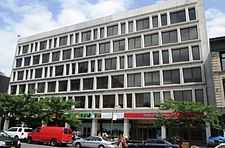Sydenham Hospital
Sydenham Hospital was a healthcare facility in Harlem, Manhattan, New York, which operated between 1892 and 1980.
History

Sydenham began in a Harlem brownstone house in 1892 as an African American hospital. Around 1924 the hospital moved to a new 200-bed building. In 1944 the staff doctors were all white despite serving a mostly African American community.[1] Soon after, it was the first hospital to have a full desegregated interracial policy with six African American Trustees and twenty African Americans on staff. It was New York City's first full-service hospital to hire African-American doctors,[2] and later became known for hiring African American doctors and nurses when other nearby hospitals would not.[3] In 1971 Florence Gaynor became the first African American woman to head a major teaching hospital, taking over as Executive Director of Sydenham Hospital during a financial crisis. She also developed a Family Care Center that included a sickle cell anemia clinic.[4]
Soon after Mayor Ed Koch took office in 1977, during severe economic troubles for New York city, he announced an additional 10% reduction in funding for municipal hospitals, and Metropolitan Hospital (in East Harlem), and Sydenham were slated for closure. There was community support of both hospitals. In January 1979, the Committee for Interns and Residents stages a one-day walkout of doctors at municipal hospitals to protest the cuts, and were often supported on picket lines by hospital workers from District Council 37 of AFSCME.[5] A “Coalition to Save Sydenham” supported legal efforts to stop the closing, organized public rallies and lobbying of elected officials, and helped publicize research to demonstrate the need for the hospital. (In 1977 the federal government designated Harlem a “medically underserved area, with the Secretary of Health, Education and Welfare Joseph Califano calling it a “health disaster area.”) While a diminished Metropolitan Hospital was saved as an “Outpatient Demonstration:” project, the city insisted that Sydenham had to be closed. In the spring of 1980, as Sydenham was about to be shut down, angry demonstrators stormed the hospital, and initiated an occupation that lasted 10 days under a so-called “People’s Administration.”[6] Despite the added publicity this brought, in 1980 Sydenham’s doors were closed for good.
Although unsuccessful, the demonstrations raised the profile of Synenham among people who had previously never heard of the hospital. Nurse and Health Activist Ebun Adelona said the closure of Sydenham became a “symbol” for Black people throughout New York to revitalize communities, improve health, and exercise political power.[7] In 1998 Sharon Lerner recalled that “The Sydenham blunder paved the way for today's more clandestine approach to hospital downsizing, in which the city reduces its contribution to the Health and Hospitals Corporation and the agency is thereby 'forced' to make cuts to the public hospitals.”[8]
Physicians
Deaths
- William Christopher Handy (1873–1958), bronchial pneumonia.[10]
References
| Wikimedia Commons has media related to Sydenham Hospital Clinic. |
- ↑ 1.0 1.1 "Harlem Shuffle". Time magazine. November 20, 1944. Retrieved 2010-12-27.
... Harlem's Sydenham Hospital ... Famed Negro Surgeon Peter Marshall Murray, an attending physician on the Obstetrical and Gynecological Service, has numerous white patients. ...
- ↑ The Restless City: A Short History of New York from Colonial Times to the ... - Joanne Reitano - Google Boeken. Books.google.com. Retrieved 2014-04-28.
- ↑ Koch (film), 2012 documentary directed by Neil Barsky
- ↑ Black Firsts - Jessie Carney Smith - Google Boeken. Books.google.com. Retrieved 2014-04-28.
- ↑ Rose Muzio, Puerto Rican Radicalism in the 1970s: El Comite-MINP. UMI 3296971, 2008.
- ↑ "Sydenham: Politics vs. Healthcare". City Limits (New York magazine). February 1983. Retrieved 2013-02-02.
- ↑ Ebun Adelona, “Sydenham: Politics vs. Health Care,” City Limits, February 1983.
- ↑ Sharon Lerner, “The Outpatient Is In,” The Village Voice, June 9th, 1998.
- ↑ "Wethers, Doris L.". Facts on File, History Database Search. Retrieved 24 February 2015.
- ↑ "W.C. Handy, Blues King, Dies at 84". Associated Press. March 28, 1958. Retrieved 2010-12-27.
... composer of 'St Louis Blues' and other jazz classics, died today at Sydenham Hospital. The blind Negro songwriter was taken to the hospital Sunday night ...